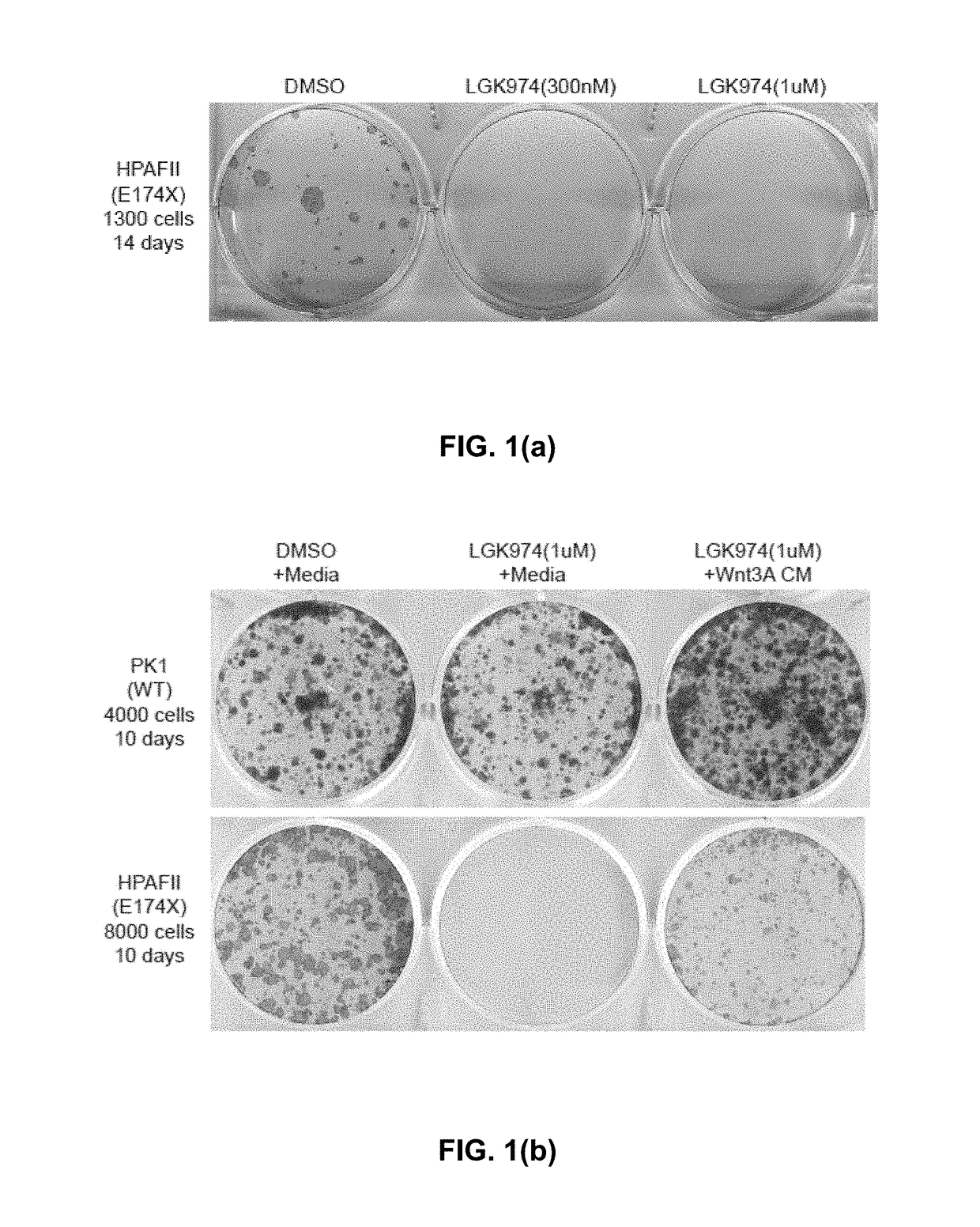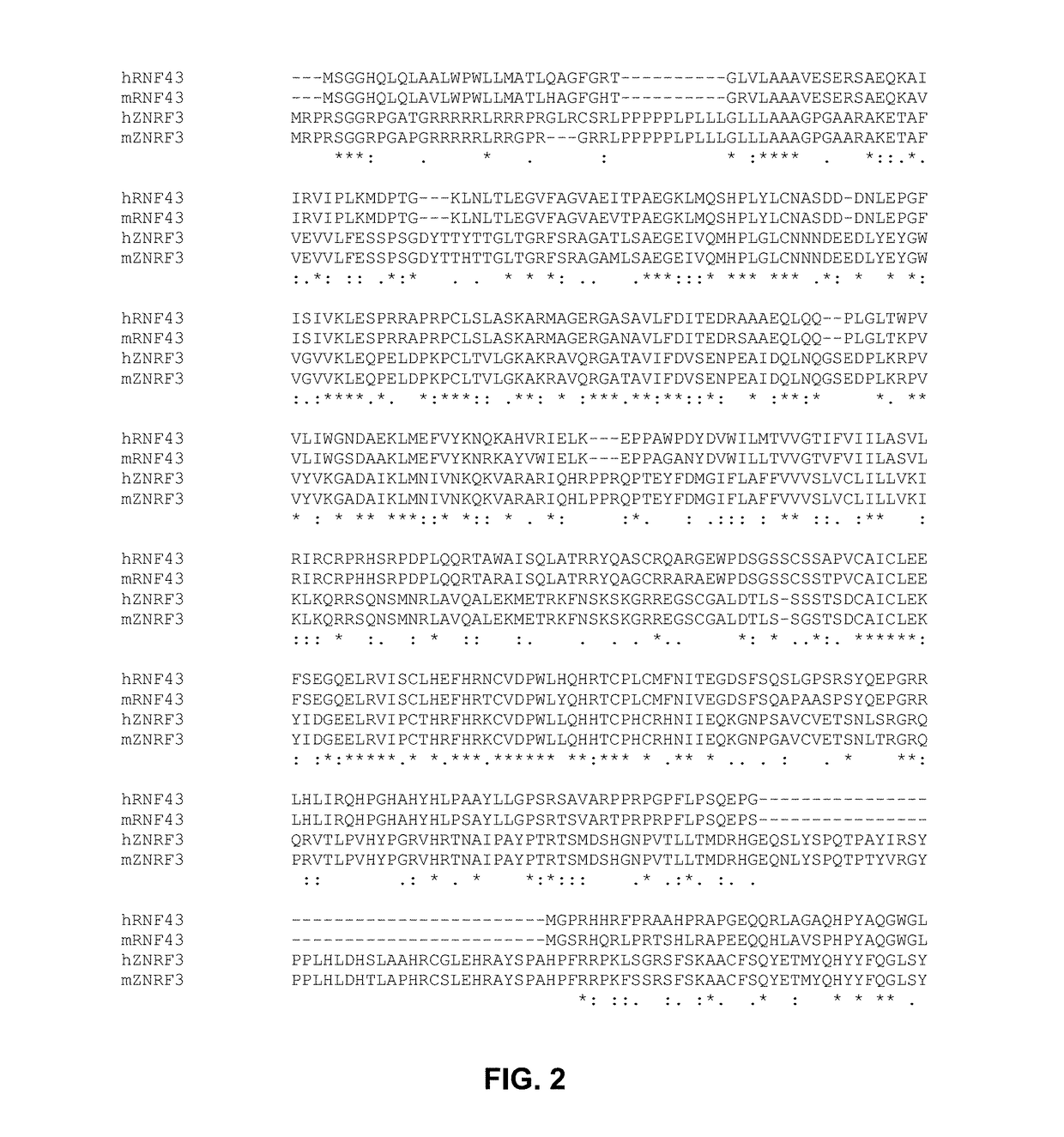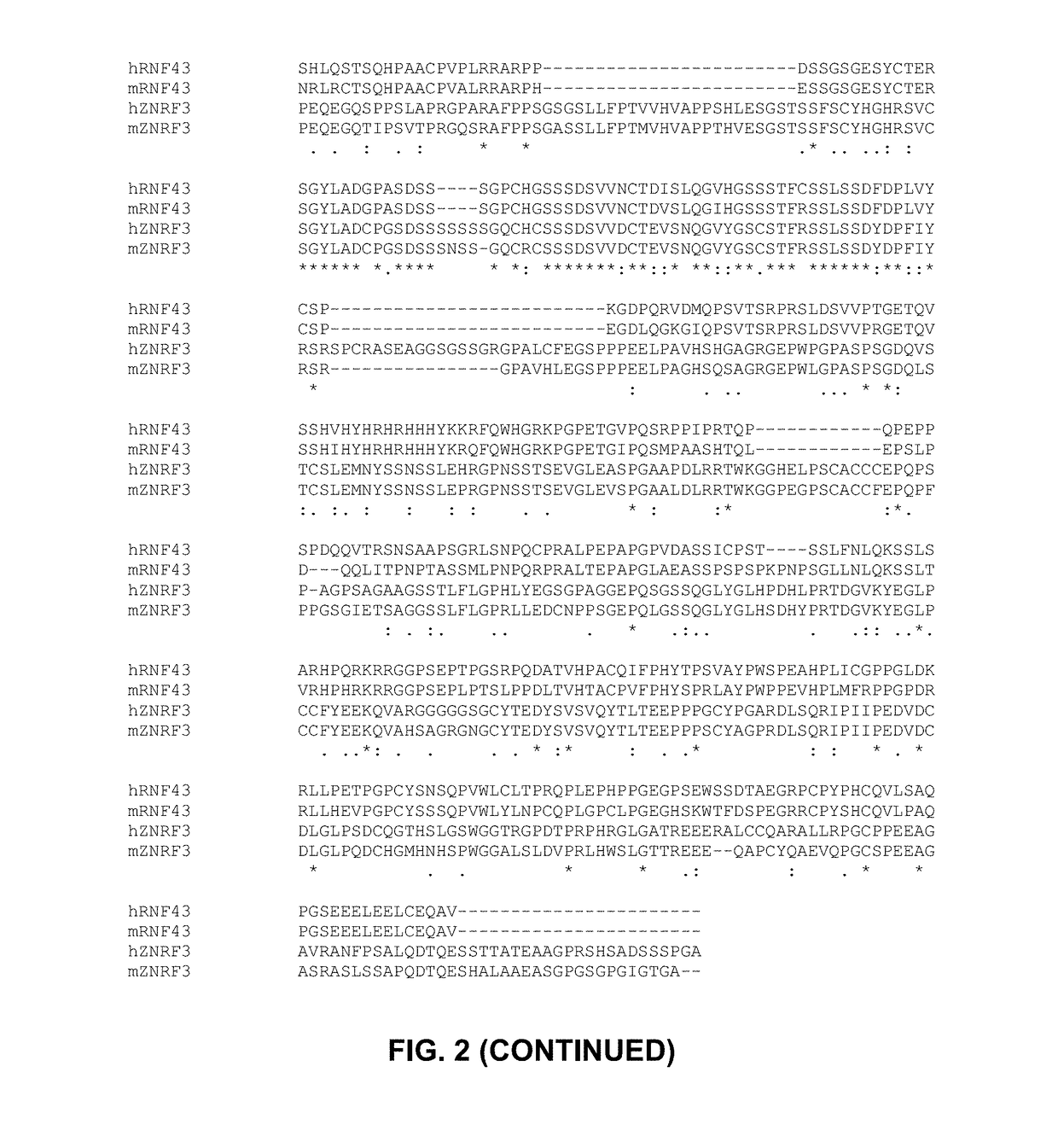Cancer patient selection for administration of wnt signaling inhibitors using rnf43 mutation status
a technology of rnf43 and tumor patient, which is applied in the direction of biochemistry apparatus and processes, instruments, drug compositions, etc., can solve the problems of hampered clinical development of wnt inhibitors and ineffective tumor treatment, and achieve the effects of increasing frizzled protein levels, increasing lrp6 phosphorylation, and increasing lrp6 protein levels
- Summary
- Abstract
- Description
- Claims
- Application Information
AI Technical Summary
Benefits of technology
Problems solved by technology
Method used
Image
Examples
example 1
[0168]As shown in TABLE 1, the RNF43 gene is mutated in primary pancreatic ductal adenocarcinoma and other tumors. Nonsense and frameshift mutations in nine genomic DNA from primary tumors of pancreas, large intestine, esophagus and skin. Of them, five are pancreatic tumors and the total number of pancreatic tumors examined is 19 (mutated in over 25% of samples, excluding potentially damaging missense mutations).
TABLE 1AAPRIMARYHISTOLOGYMUTATIONCHANGEIDPATHOLOGYSITE(SUBTYPE)AGEnonsensep.R337XX-1633primarypancreascarcinoma44(ductalcarcinoma)frameshiftunknownX-1948primarypancreascarcinomaNA(ductalcarcinoma)frameshiftunknownX-2406primarypancreascarcinomaNA(ductalcarcinoma)frameshiftunknownX-3184primarypancreascarcinoma55(ductalcarcinoma)frameshiftunknownX-3268primarypancreascarcinoma78(ductalcarcinoma)frameshiftunknownX-2239primarylargecarcinoma76intestine(ductalcarcinoma)frameshiftunknownX-3205primarylargecarcinoma78intestine(adenocarcinoma)frameshiftunknownX-1433metastasisesophagusca...
example 2
[0169]As shown in TABLE 2, the RNF43 gene is mutated in multiple pancreatic cancer cell lines. Genomic variations identified by Sanger sequencing in 10 pancreatic cancer cell lines potentially with only one copy of RNF43 gene left based on copy number analysis. Three unique cell lines with RNF43 inactivating mutations were identified: HPAFII (nonsense mutation), Panc 10.05 (frameshift mutation, related with PL45 cells), PaTu-8988S (detrimental mutation, related with PaTu-8988T cells).
TABLE 2CELLGENEcDNAAALINENAMECHANGEEXONCHANGEConservationCommentsPK-1RNF43c.g350a2p.R117HNoHPAFIIRNF43c.g520t4p.E174XYesNon-functionalPancRNF43c.54insatca1p.M18fs~Non-functional10.05PL45RNF43c.54insatca1p.M18fs~Non-functionalPaTu-RNF43c.t206g1p.F69CYesNon-functional8988SPaTu-RNF43c.t206g1p.F69CYesNon-functional8988TKLM-1RNF43c.g350a2p.R117HNoCapan-1RNF43c.c692t6p.P231LNoBoth non-polarand hydrophobicKP1NRNF43c.c692t6p.P231LNoBoth non-polarand hydrophobicPANC-1RNF43c.c692t6p.P231LNoBoth non-polarand hydro...
example 3
Canonical Wnt Pathway Inhibition by LGK974
[0171]The sensitivity of pancreatic cells to LGK974 treatment were tested in a cellular proliferation assay in vitro. Twenty four human pancreatic cancer cell lines were treated with or without LGK974.
[0172]Cellular proliferation data was generated in 384 well format. Cells were harvested and resuspended in their appropriate growth medium at a density of 1.5×104 cells per mL. Cells were then plated into 384 well tissue culture plates (Greiner-BioOne 789163) at a final volume of 50 μL per well to achieve a per well density of 750 cells per well using a BioTek pFill dispenser (Serial number 000-3586). Plates were then transferred to incubators on the ACP-1 system (37° C., 5% CO2) and cells were allowed to attach overnight. A 12 point dose response curve for LGK974 was prepared in a 384 well ECHO compatible source plate (Labcyte P-05525) with a highest concentration of 2 mM and a lowest concentration of 1.13×10−5 mM. Approximately 18 hours afte...
PUM
| Property | Measurement | Unit |
|---|---|---|
| slice thickness | aaaaa | aaaaa |
| pH | aaaaa | aaaaa |
| pH | aaaaa | aaaaa |
Abstract
Description
Claims
Application Information
 Login to View More
Login to View More - R&D
- Intellectual Property
- Life Sciences
- Materials
- Tech Scout
- Unparalleled Data Quality
- Higher Quality Content
- 60% Fewer Hallucinations
Browse by: Latest US Patents, China's latest patents, Technical Efficacy Thesaurus, Application Domain, Technology Topic, Popular Technical Reports.
© 2025 PatSnap. All rights reserved.Legal|Privacy policy|Modern Slavery Act Transparency Statement|Sitemap|About US| Contact US: help@patsnap.com



